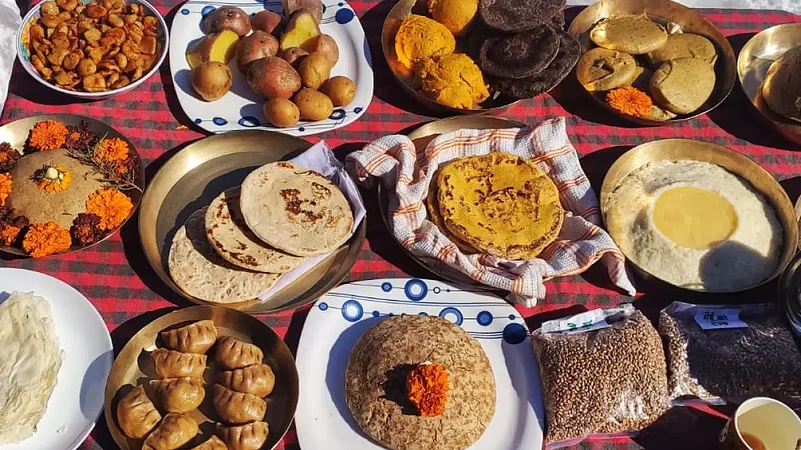Food has always been a luxury in the remote and high altitude desert valleys of Spiti and Himachal Pradesh and continues to remain a fascinating delight for interlopers. Spiti cuisine continues to thrive due to its distinctive culture and lifestyle, influenced by Tibetan culture and the limited availability of ingredients.
Most traditional foods of this remote region are easy to cook -- boiled, steamed or fermented -- and consumed with little dependency on supplies of ingredients from outside. No matter the landscape outside which might be laden under 8-10 feet of snow, a kitchen in Spiti has everything it needs inside it.
Abundant use of locally grown ingredients like millets, grains and meat, which are dried in the summer and carefully stored for winter, play a significant role in the survival of the population, which has thrived on self-dependence due to its geographic isolation.
Climatic conditions in this snow-bound valley, located at a height of 15,000 ft, are perhaps the reason for the popularity of Spiti’s own traditional food varieties among locals. These form their daily meals and are also part of community feasts during fairs and festivals.
Some of the highly popularly dishes include thukpa -- a one-pot soupy meal of hand-torn noodles, vegetables and meat; dried meat; savoury butter tea; all downed with the locally brewed alcoholic drink chhang. The meal provides a perfect balance of proteins, fibres, carbohydrates and minerals.
“Spitians rely mostly on staple food. During winters, we consume food items based on native crops, herbs and vegetables. Powdered or whole-grain barley is central to it. Meat eating is a necessity, both for its supply of proteins and minerals, as well as the warmth its fat provides,“ says Tsering Bodh Sakya, a social activist and hotelier.
For years, the denizens of Spiti, Pangi, Lahaul and Kinnaur have followed a practice of bulk storage of food items and ingredients for the six months of winter (or till the snow lasts). Green vegetables -- leafy farm produce, potatoes, radish, peas, tomatoes, carrots and cabbages -- are dried or fermented for storage. Meat-eaters slaughter goats or sheep and dry the meat.
There is a separate storage facility in every house for mutton, chicken, eggs, grains, pulses and other ingredients. These are taken out as per need, cooked in the traditional manner and eaten.

Tsampa – a flour made from roasted and ground barley -- is eaten in many ways -- by mixing with tea or boiled with vegetables. Adding ghee, dried meat and dried yak cheese to tsampa and cooking it in yak or lamb stock to make porridge is a nutritious breakfast, especially in winters. It's called tsam-thug.
Neeraj Chaudhry, a Solan-born executive chef with a leading international hotel chain, who recently wrote a book on traditional food items of Spiti -- A Peep Into Spiti Cuisines, says, “Spitian food, in principle, follows the philosophy of Buddhist peace food. It’s simple, nourishing and best suited for local climatic conditions. Since there is a limited working season, most of the items are stored, dried and stashed properly for the snow-locked days. Simple cooking doesn't need prolonged procedures or creativity."
Chaudhry admits that despite creeping modernity -- which Spiti has seen over the years due to increased travellers, mobility of Buddhist monks, educated youths moving out from the valley or returning to set up their ventures -- the basic culinary traditions have remained unchanged -- boiling, steaming, fermenting.
“There is always an effort within the community to preserve their ancient foods and promote them during traditional festivals, fairs and religious events.
"The Snow Festival, held during the winters of 2020 and 2021, provided a great opportunity to showcase old and traditional dishes by tribal women," recalls Pankaj Rai, IAS, who served as Deputy Commissioner, Lahaul-Spiti a year back.
But what they love most is their thukpa. These days, tourists can savour the delicacy, cooked the Spitian way, at restaurants in Kaza, Keylong, Kinnaur and Sangla.
Minakshi Chaudhry, a noted Shimla-based writer who did her research on ancient dishes of high altitude regions, has traced the influence of Tibetan culture on the traditional food of Spiti, as this was an ancient trade route to Tibet. “Tibetan cuisine has become a mainstay of Lahaul and Spiti, born from centuries of interactions with Tibetans. A delicious result is thukpa. The Spitians have done a lot of innovation to make it more delicious, nourishing and befitting the climatic conditions of India,” she says.
Another tasty delight is thinduk-chindukis -- crushed barley and black pea cooked with rakchemar (apricot oil). It is stored frozen and boiled when required. Tsampa is also added to the dish for thickening.
Then there are items like chaaku-chaa (butter tea), jimjag (drochag) kyu, thentuk, Spiti momos, churpe, steamed dumplings and chiltas.
Dr Ram Lal Markanda, minister for tribal affairs and Lahaul-Spiti MLA, says every valley has its own traditional dishes and politics around these. “There is an effort underway to preserve these ethnic foods and make value-additions, as a lot of tourists also look for organic and authentic tribal cuisines. It has also started generating employment," he claims.



























